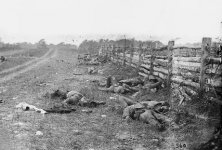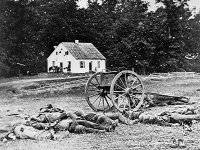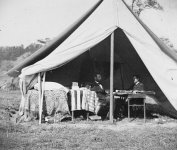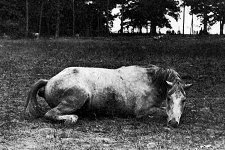jazzeum
Four Star General
- Joined
- Apr 23, 2005
- Messages
- 38,439
Yesterday, September 17 was the 150th anniversary of the Battle of Antietam/Sharpsburg, one of the bloodiest days in American History that resulted in enough of a Union victory to change the Civil War.

Confederate dead along the Hagerstown Road, Antietam.

Dead by the Dunker Church
![1862-09-17-Battle-of-Antietam-Army-of-the-Potomac[1].jpg 1862-09-17-Battle-of-Antietam-Army-of-the-Potomac[1].jpg](https://forum.treefrogtreasures.com/data/attachments/83/83335-b9eccb094097e06f0fbdfeb0fcec7352.jpg)
Fighting Along the Burnside Bridge
As recounted in yesterday's Disunion post, the Confederacy's invasion of the Northern territory was turned back, convinced wavering European nations such as England and France to withhold recognition from the Confederacy, allowed Abraham Lincoln to announce the preliminary Emancipation Proclamation on September 22 and persuaded the president that George B. McClellan was not the man for the job.

President Lincoln meets with General McClellan at Antietam after the battle.
More than anything it led to the Emancipation Proclamation, which Lincoln had announced to the Cabinet in July but had held off on Secretary of State Seward's advice that the Proclamation not be announced until the Union Army had secured a victory. Anything short of that would smack of desperation.
Please also see this post in Professor Brooks Simpson's Crossroads blog, where he recounts his ancestor James Denton at the Battle of Antietam and a possible encounter with the ancestor of Brooks Simpson's wife.

Confederate dead along the Hagerstown Road, Antietam.

Dead by the Dunker Church
![1862-09-17-Battle-of-Antietam-Army-of-the-Potomac[1].jpg 1862-09-17-Battle-of-Antietam-Army-of-the-Potomac[1].jpg](https://forum.treefrogtreasures.com/data/attachments/83/83335-b9eccb094097e06f0fbdfeb0fcec7352.jpg)
Fighting Along the Burnside Bridge
As recounted in yesterday's Disunion post, the Confederacy's invasion of the Northern territory was turned back, convinced wavering European nations such as England and France to withhold recognition from the Confederacy, allowed Abraham Lincoln to announce the preliminary Emancipation Proclamation on September 22 and persuaded the president that George B. McClellan was not the man for the job.

President Lincoln meets with General McClellan at Antietam after the battle.
More than anything it led to the Emancipation Proclamation, which Lincoln had announced to the Cabinet in July but had held off on Secretary of State Seward's advice that the Proclamation not be announced until the Union Army had secured a victory. Anything short of that would smack of desperation.
Please also see this post in Professor Brooks Simpson's Crossroads blog, where he recounts his ancestor James Denton at the Battle of Antietam and a possible encounter with the ancestor of Brooks Simpson's wife.
Last edited:


